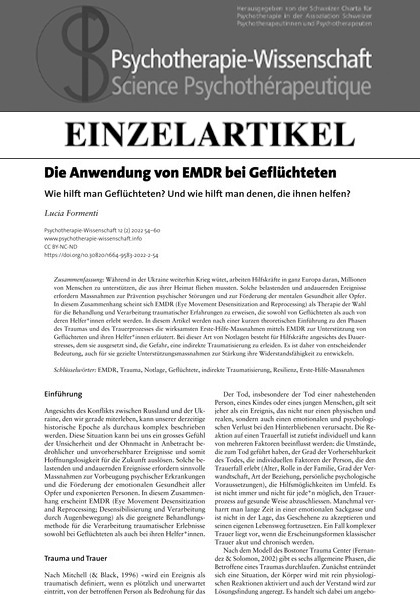The use of EMDR with refugees
How can refugees be helped? How can those supporting them be helped?
DOI:
https://doi.org/10.30820/1664-9583-2022-2-54Keywords:
EMDR, trauma, emergency, refugees, indirect traumatization, resilience, first-aid measuresAbstract
While the war in Ukraine rages, aid workers across Europe are working to support millions of people forced to flee their homes. Such distressing and prolonged experiences require measures to prevent the development of psychological disorders and promote the mental health of all victims. In this context, EMDR appears to be the therapy of choice for treating and dealing with the traumatic experiences of both refugees and those providing support. In this article, after a short theoretical introduction looking at the phases of trauma and the grieving process, the author explains the most effective first-aid measures using EMDR to support refugees and those helping them. In this type of emergency, aid workers are at risk of suffering indirect traumatization from the constant stress to which they are subjected. Therefore, it is of vital importance that targeted supportive measures are developed to strengthen the resilience of those providing support.
Downloads
How to Cite
Formenti, L. (2022). The use of EMDR with refugees: How can refugees be helped? How can those supporting them be helped?. Psychotherapie-Wissenschaft, 12(2), 54–60. https://doi.org/10.30820/1664-9583-2022-2-54
Issue
Section
Special Issue
License

This work is licensed under a Creative Commons Attribution-NonCommercial-NoDerivatives 3.0 Unported License.
This journal provides open access to its content in accordance with the basic premise that the free public availability of research benefits the exchange of knowledge throughout the world.
Authors wishing to publish in this journal agree to the following:
- The author/s retain/s the copyrights and consent/s to initial publication of the work in the journal under a Creative Commons Attribution licence, which allows third parties to use the work by citing the name/s of the author/s and this journal as initial publisher (in accordance with the Creative Commons Attribution-NonCommercial-NoDerivs 3.0 DE-Licence).
- The author/s can enter into additional contracts for the non-exclusive distribution (e.g. publish in a collection or book) of the version published in the journal, if the journal is cited as initial publisher.


